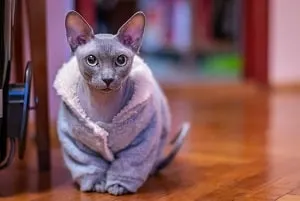 The Sphynx cat’s unique appearance tugs at the heartstrings or causes a strange fascination among their admirers, and there is no shortage of fan pages across the internet. Those very images prompt an exciting question as sphynx appear in every kind of outfit from the mundane to the outlandish – do they need to wear those clothes?
The Sphynx cat’s unique appearance tugs at the heartstrings or causes a strange fascination among their admirers, and there is no shortage of fan pages across the internet. Those very images prompt an exciting question as sphynx appear in every kind of outfit from the mundane to the outlandish – do they need to wear those clothes?
So, do Sphynx cats need to wear clothes? No, Sphynx cats do not need to wear clothes. Sphynx cats have an average body temperature between 99.5-102.5F (37.5-39.1C) – higher than cats with fur. During warmer months, or when living in tropical climes, they may be comfortable without clothes. When the season shifts into winter, it’s okay to use sweaters and other clothing to help keep your cat warm.
Although Sphynx cats don’t need to wear clothing, it isn’t uncommon to find a sphynx gravitating towards sun-filled windows, blankets, the heating vent, or even their owner’s warm bodies. Whether that translates to a need to break out the tiny sweaters and hoodies depends entirely on the sphynx and its personality.
Sphynx Cats And Their Need For Warmth
Sphynx cats are unique in a lot of ways, their hairless appearance topping the list. The lack of an insulating layer of fur presents a challenge, especially when it comes to warmth. While the sphynx is one of the more vocal cat breeds, they still can’t tell us to turn up the thermostat, so here are other clues to watch for:
The best gauge to use is human preference: if anyone feels chilled and finds themselves reaching for a sweater or blanket, then the sphynx feels cold, too. That elevated body temperature means they should feel warm to the touch at all times, so a cool body is a big red flag. The paws and ear tips will be the first to lose that crucial body heat.
If there are hardwood floors or tile in the house that the sphynx refuses to walk on, odds are it’s too cold. The toes are exposed and sensitive, and a refusal to walk on chilled surfaces is a sign the cat is feeling uncomfortable.
Sphynx cats bond tightly with their chosen owners, and they like to be in the middle of everything, but if they seem unusually attached (i.e., they literally won’t leave someone’s lap), they might be trying to leach heat from that body.
This cat breed should be constantly active throughout the year, so a suddenly lazy sphynx is a concern. They may be trying to conserve energy to stay warm. A shivering sphynx is a severe sign – that means extreme cold and possibly hypothermia. They need immediate warm-up and might need to visit the veterinarian for more urgent care.
Keeping A Sphynx Warm Through The Winter
Keeping a sphynx warm through the winter or even in the summer when the air conditioning is running – is relatively simple. Blankets made from fleece or other soft fabrics that won’t irritate the cat’s sensitive skin can be left in their favorite sun spots or near heating vents. Heating pads aren’t recommended as they can burn the cat’s skin. Self-heating cat beds are a much safer alternative.
Cat igloos or covered beds create little pockets of warmth for a sphynx to snuggle into, with extra blankets added, if needed.
Sphynx cat clothing is s a booming market and a simple internet search away. However, it’s essential to take a particular sphynx’s personality and tolerance into consideration. Not every sphynx accepts clothing. They may become rigid, fall over and remain immobile, or even scratch and bite when attempts are made to dress them. If the cat tolerates clothing, make sure to choose breathable fabrics that provide some stretch to allow them to move naturally.
Also, regular clothing changes are essential – cats like clean clothes, too. With all clothing and blankets, regular laundering is significant as oils from the cat’s skin will accumulate on the fabric and lead to odors. A hypoallergenic laundry detergent (no dyes or scents) is best to prevent any skin reactions.
Summer Weather Can Be A Concern For Sphynx Cats
Sphynx gravitate towards warmth, but sunbathing can prompt just as many problems as cold. Their hairless skin is prone to not only sunburns but skin cancer, as well, so precautions need to be made during the summer months.
• For cats that have favored lounging places in the sun, apply UV film to the windows to limit the harmful radiation coming through the glass.
• If the sphynx ventures outdoors, there are veterinary-safe sunscreens available.
• For sphynx that tolerates clothing, they manufacture long-sleeved sun-protective clothes.
Giving Your Sphynx A Bath
A lack of fur means that Sphynx cats have no way for the oils they secrete to get absorbed. Instead, the oils accumulate on the skin, attracting dust and clogging pores; left alone, this leads to infection. Most sphynx are acclimated to baths by the breeder when they’re tiny kittens, and they come to enjoy the process – a good thing since they need a bath a minimum of every week! Without regular bathing, sphynx leave reddish-brown marks on sheets, furniture, clothing, and their owners.
Baths should be warm – not hot – with the faucet turned off. Use a gentle shampoo recommended by a veterinarian (no human shampoos, not even baby shampoo), and thoroughly soap the sphynx, with careful attention between all of the toes. Rinse all of the soap off afterward, so no residue is left behind. Dry the sphynx thoroughly to prevent any risk of a chill, especially if it’s cold outside.
Keeping A Sphynx Cat Clean
The sphynx’s oily skin presents additional challenges, especially if their pores become clogged. Believe it or not, they can develop blackheads, primarily on the chin – yes, they get kitty-acne!
The skin needs gentle scrubbing with warm water and a veterinarian-approved antibacterial soap. The affected area can then get swabbed with a cotton ball soaked in witch-hazel, followed by a rinse of cold water (licking the witch-hazel will make them sick). This routine incorporates well with the weekly bath.
That lack of fur makes the collection of dirt and debris in the sphynx’s ears easy, and these cats produce large amounts of dark brown earwax, to boot. If left alone, the ear canals can block, and infection can develop, not to mention that wax and dirt getting smeared on furniture and clothes.
Regular cleaning with cotton balls and a veterinarian-prescribed cleaner – ideally when the sphynx is getting its bath – will keep this wax and dirt from becoming a problem.
Most cat owners have their cats’ nails trimmed regularly; for sphynx cats, nail trims are especially crucial. There’s no hair to protect their delicate skin, and scratching themselves with nails that have walked through the litterbox leads to infection. Even clean nails damage the skin, so regular nail trims need to fit into an owner’s grooming schedule.
Immediately after the bath, nails are at their softest, and they are easiest to trim. Applying soft nail caps are another option owners can consider protecting their sphynx.
Final Thoughts
The sphynx cat is unique in appearance, and they provide unique challenges in their care. Their hairless condition presents a need for warmth, regular grooming, and protection from the sun’s rays. Not every cat tolerates getting tucked into clothing, whether they’re cold or not. Meeting the sphynx’s need for warmth – and recognizing the signs of “I’m cold” – is absolutely a valid concern for these unusual cats. Loyal sphynx fans promise that all of the extra concern is worth it to snuggle up with these affectionate cats – with or without the clothing.

My name is James, and welcome to FAQCats!
Along with our team of cat owners, expert pet enthusiasts, and pet professionals, we aim to write engaging helpful, engaging content about cats. At FAQCats we strive to provide content that’s accurate and fun to read. Our team writes about everything related to cats; even the most complex of topics. Through extensive research and caring for our own fur-pals, we’re able to provide something cat owners worldwide will love. Have a look around, and leave us feedback anytime!

